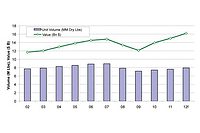STRATEGIC SOLUTIONS: Marching Toward "Green"

Nearly 1,000 attendees at the 2008 World Adhesives Conference in Miami, FL, listened to global industry leaders discuss challenges and trends within the adhesives industry. The common theme was “Reducing Environmental Impact.” Alan Bate, formerly executive vice president of National Starch and Chemical Ltd., focused his message on reducing environmental impact through innovation. His presentation highlighted efforts in reducing the carbon footprint, increased recycling content in materials, use of renewable resources and enhancing biodegradability. Bate also emphasized sustainability through energy-reduction innovation.
Likewise, Alois Linder, executive vice president-Adhesives Technolgies at Henkel KGaA, emphasized sustainability. He stated that sustainability is an opportunity for the adhesives industry. In the words of Dr. Ulrich Lehner, former chairman of the Management Board of Henkel KGaA, “sustainability equals future viability.” Therefore, sustainability is part of Henkel’s DNA, according to Linder.
While sustainability is not a new theme, greater emphasis is put on it based on the peril our planet and future generations face. Linder shared the Brundtland Commission 1987 report summary that stated “Sustainable development is development that meets the needs of the present without compromising the ability of future generations to meet their own needs.” He identified five driving forces for sustainability in our industry.
- Public Awareness. The possibility of raising the industry's reputation through proactive engagement.
- Legal Requirements. The increasing number of regulations impacting the adhesives industry, such as REACH, RoHS, TSCA and “Green Building.”
- Customer Standards. Increased focus on “Green” solutions and banning of chemical substances from product and production processes.
- Economical Benefits. Assigning “carbon ratings” and reduction of emissions throughout the supply chain.
- Need for Sustainable Solutions. Innovative solutions enabling adhesive customers to reduce wastewater costs, cleaning steps, and operating temperatures, thereby saving energy costs.
- Non-Hazardous Materials. Using reactive and waterborne vs. solvent-based materials, isocyanate-free and/or silane-modified polymers vs. isocyanates, etc.
- Renewable Materials. Developing renewable polymers and revisiting natural materials such as rosin, starch, fatty acid dimers, etc.
- Recyclability. Developing biodegradable/compostable adhesives, adhesives that are recycling compatible and “de-bonding on command” systems.
- Low Carbon Footprint. Conducting lifecycle analysis and approaches, such as the “Green Building” standard.
His analysis shows that we have a long ways to go. He said that, presently, adhesives based on renewable technology have the following pro and con characteristics.
Pro
- Favorable bio-compatibility
- Positive GHG balance
- Good price/performance ratio
- Availability
- Low to no toxicity
Con
- Suitable for low- to medium-modulus adhesives only
- Often denaturation through chemical modification
- Often requires biocides to prevent microbial decay
- Quality consistency
- Limited thermal stability

Not included in these figures of 15+% share are those areas where the polymer molecule is at least in part formed on natural building blocks (i.e., polyurethanes based on oleochemical-based polyols, polyesters and polyamides based on dimeric fatty acids).
While we have much work to do yet, “natural”-based materials will now and in the future play an important performance-governing role as binders and additives in adhesives, particularly in the B2C area. With further progress in biopolymers, it cannot be excluded mid- to long-term that this will reverse the trend towards focusing on renewable rather than depletable sources.
For more information, phone (513) 469-7555 or visit www.chemquest.com.
Links
Looking for a reprint of this article?
From high-res PDFs to custom plaques, order your copy today!





